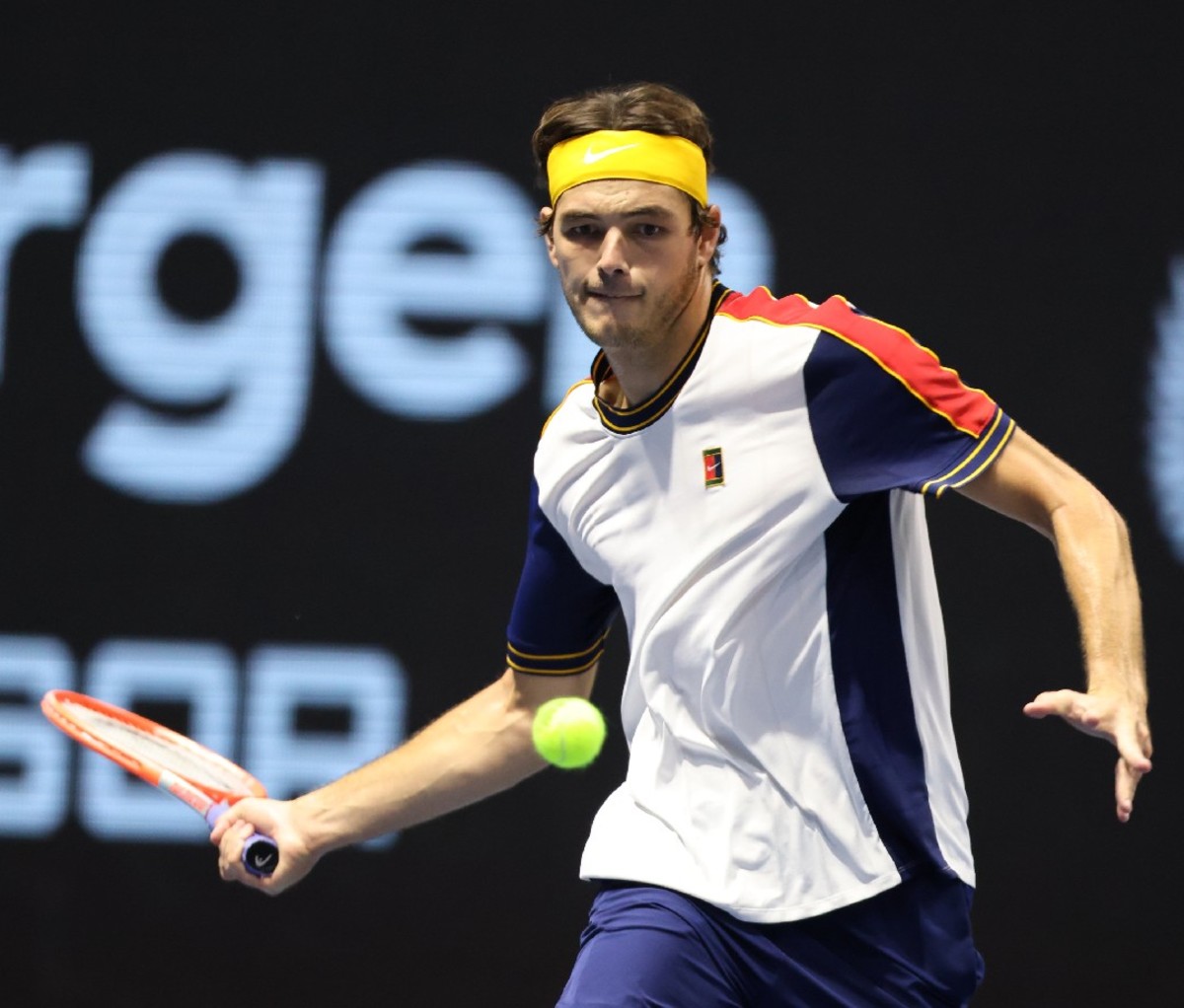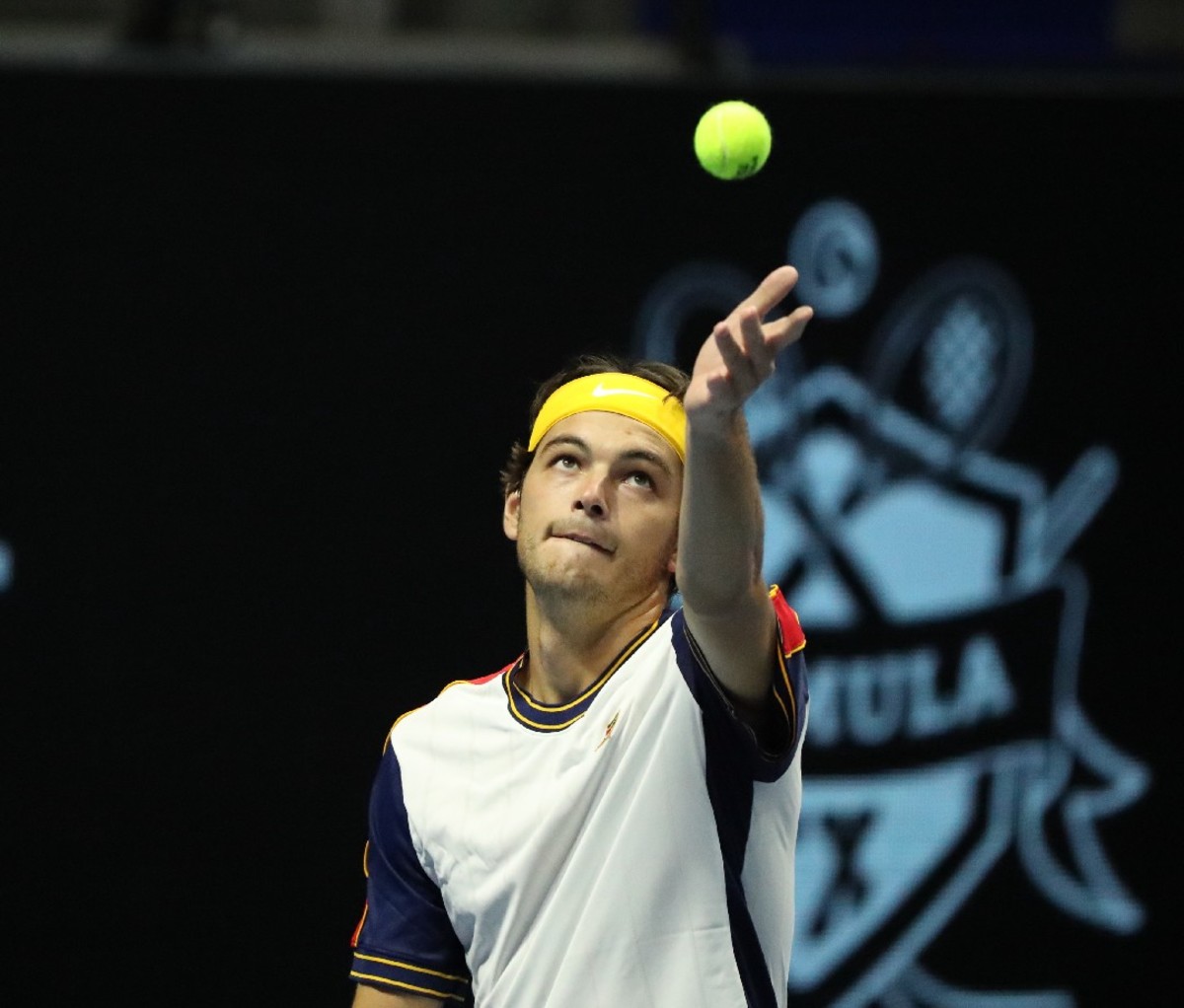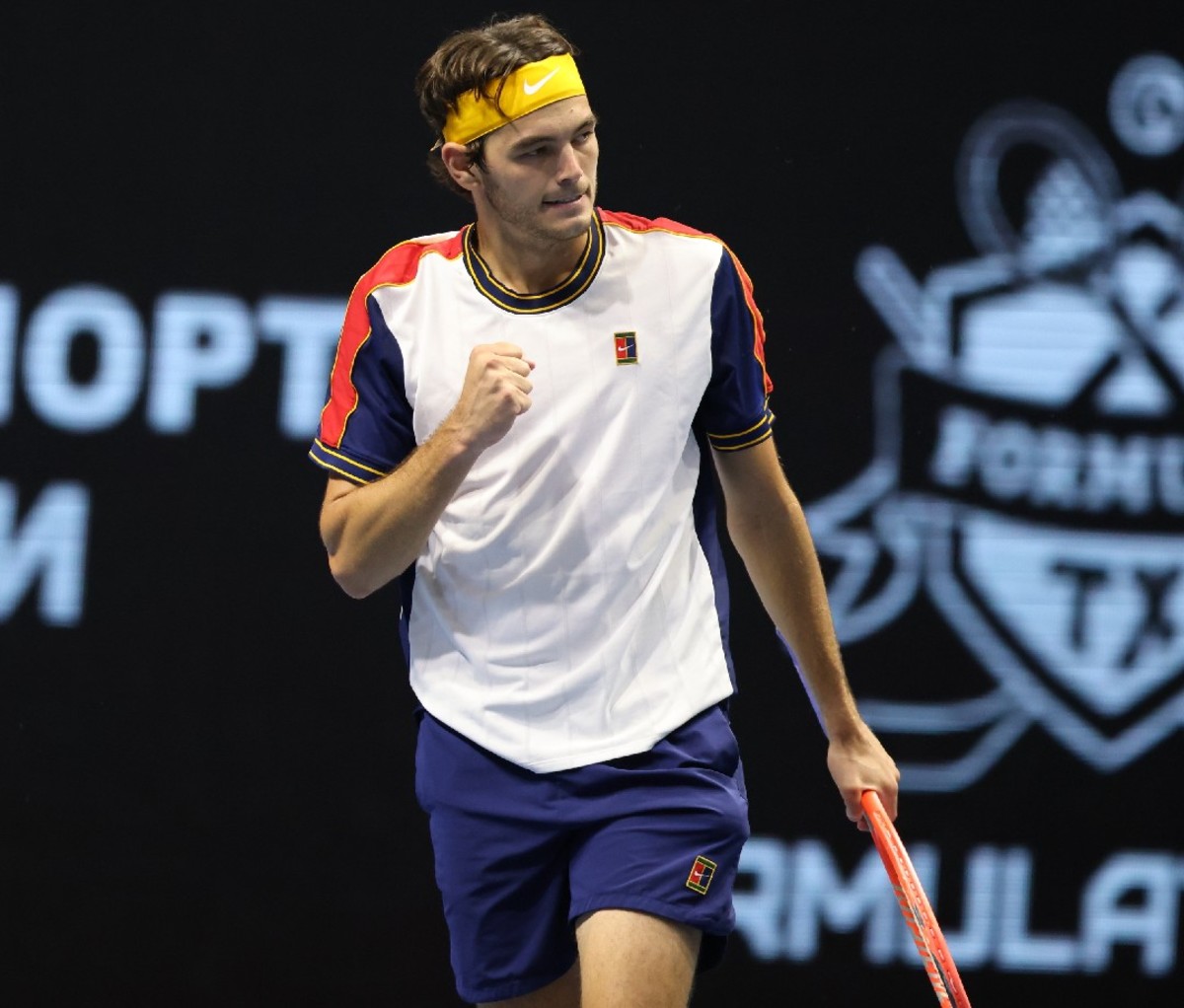Taylor Fritz is no stranger to immense pressure or playing injured, having dealt with plenty of both over the past few years. The 25-year-old is one of America’s brightest tennis stars, cementing his place in the sport’s history after defeating Rafael Nadal at the Indian Wells Masters last March—and becoming the first American to win the event since Andre Agassi back in 2001. Since then, he’s been hampered by frustrating stress fractures in his ankle, which started around that momentous event.
Despite those challenges, Fritz’s competitive spirit has remained intact, and now that he’s recovered physically, the performances have been beyond impressive. Just this month, the 6’5” contender helped Team USA clinch the inaugural United Cup trophy by defeating Italy’s Matteo Berrettiini in an intense back-and-forth match, followed by a career-high 32 aces during his first match at the Australian Open.
We dropped into the Equinox Hotel to meet with Fritz and talk about his training, recovery, and squaring up against legends on the hardcourt.

Men’s Journal: It takes an army. Who do you bring along for big tournaments?
Taylor Fritz: These days, I bring coaches Mike Russell and Paul [Annacone], who doesn’t stay the whole tournament but gets here the first week, and my physical therapist, Wolf[gang Oswald]. That’s the team that I’m traveling with through most of the year, and I’m glad to have found the people I have for these events. I trust them to get me where I need to be to compete.
You went through a tough injury last year. What’s the status of your ankle?
When I had pain early last year, I went to get it scanned after it got pretty severe. It took getting to that point for me to realize I needed to have it checked out. I’m pretty used to dealing with pain after practice. When we discovered the issue from the scan—a stress fracture—I took about three weeks off last spring. Since then, it has honestly felt pretty fine. There have been times when I’ve felt some pain, but for the most part it’s been good. I took another small break for two weeks after Wimbledon, but these days I’ve been playing through it.
I’ll be honest, it’s tough to know exactly how hard I can go on it. Luckily, we got some reassurance recently from a CT scan that let us see everything going on in there, and it’s more on-the-surface. I’m not at risk of a serious break that would displace the bone and put me out of competition for a long time. I don’t want to do anything where I’d have to do a big surgery and get screws put into my leg, but thankfully it looks like I’ll have more warning signs before it ever gets to that level. I feel pretty comfortable playing to my full capacity this tournament.

What’s your training schedule like in the days leading up to a tournament?
I’ve been doing two to three hours on the court. Then we do about an hour of upper- or lower-body lifting with 30 minutes of cardio in between. The week before, we tamp it down a bit so I can be fully recovered by the time I’m playing. The exercises I’m doing are pretty standard. For an upper-body day, I’ll do dumbbell bench press, rows, and curls. On a lower-body day, I’ll do exercises like lunges, hamstring curls, calf raises, and hip trusts. Every training routine we do has a bit of core work in there. Leading up to a tournament, it’s important to do movements that I’m familiar with to avoid injury before a match. I never train the day before. I‘ll try to keep that heavy volume going until we’re about three days out.
Do you have any exercises or routines that directly correlate to your ability to play on the court?
I know it might sound boring, but I’ll do a lot of rotator cuff exercises with the cable machine to give myself a stronger serve. I remember being out of the game with a shoulder impingement when I was 16 or 17 and I was doing those exercises for three weeks. I came back serving bigger than ever. So now I’ll do it either on the cable machine or with dumbbells with decent weight for about 15 reps a set.
Do you rely on cardio to help your lasting power?
I’ve found that no matter what kind of cardio I do, nothing really prepares me for playing on the court. I don’t know what it is about being on the court and swinging the racket but if I don’t do it for three weeks, I’ll be gassed doing it for one match. I don’t care if I’ve spent every day of those three weeks on the assault bike or VersaClimber, I’m going to be gassed. That’s why I’ve become very insistent on getting my cardio done on the court.

Given how intense the training days can be, how important is it to find the right place to stay while you’re on the road at tournaments?
I’ve gotten really used to the travel and having to relocate for matches. There aren’t many times throughout the year that I’m setting up a base because I’m not really living anywhere more than a week. Since there’s an event almost every seven days, it’s rare I’m ever unpacking. That’s a little different when you’re playing a Grand Slam. Because they’re a bigger deal, I’ll skip the tournament before to get an extra week to acclimate. Grand Slams are also two-week tournaments. It’s more important to find the right base because I have about a month in one place. Ideally, there’s somewhere I can go for a cold plunge or cryotherapy.
Speaking of packing bags, what are your must-haves in terms of what you’re bringing to tournaments?
I’m lucky that for a Grand Slam event like this my clothing sponsor, Nike, will put together a big suitcase of gear for me to wear—everything I’ll wear during the matches. I’m traveling for months, so in that regard it’s probably even a little light when you think about how long I’m away for. But the bags I’m bringing are just stuffed with training gear because I’m sweating through everything super quick.
How difficult is it to meet your nutrition needs?
I weighed myself when I got here, and I was a little bit heavier than I want my playing weight to be. I came here at 202 pounds, and I like to play somewhere between 192 to 195 pounds. I weighed myself the other day and I’m at 195.2 pounds, so I’ve lost about seven pounds. That makes sense when you take into account how hot it is out here and that I’m training about five hours a day. I’m trying to eat as much as I can, with plenty of protein, so that I have energy to train and everything I need to put on muscle. I don’t have a number I’m trying to hit when it comes to carbs, but I try to eat appropriately to how much training I’m doing. The last thing I want to do is eat away the muscle I’ve built up. I’m probably burning somewhere between 5,000 to 6,000 calories a day.
What does an average day of eating look like leading up to a tournament?
For breakfast, I may go to Starbucks and hit some of their egg white bites, just because that’s easy protein. I’ll also go for a breakfast burrito with eggs and potato. For lunch, I’ll go to Chipotle a lot. I’m a big fan of their bowls with chicken and rice, I’ll do a few salads in there as well. I’ve gotten good at finding fast food options that’ll get the job done. For dinner I eat a lot of steak with vegetables and rice. I guess the next step would be to get a personal chef or something like that, but right now we’re just handling it ourselves.
Are you big on recovery?
I probably put more effort into recovery and preparation than other players on the tour from what I’ve seen. I do an hour on the table for body work with my physio before I even step on the court. That’s him warming up the body and going over some of the muscles with a Theragun. Anything that might be sore from the previous day we’ll spend some extra time on. Once we’re done with that, I’ll do about 30 minutes of warmup with dynamic exercises before I get on the court. The day is finished with another hour and a half of massage with recovery. I’ll always hop into an ice bath after any hard practice and especially after a match. I’ve discovered the ice bath hits a little different between 48 to 52 degrees. I’ve gotten to the point where I feel like if I’m not doing a cold plunge then I’m not doing everything I need to succeed.
Do you have a sleep quota you try to hit during a tournament and training week?
I’m looking to get eight and a half hours of sleep—minimum—especially after the heavy training days I’m doing. Ideally, I’d like to get 10 hours. Falling asleep is pretty easy for me. I’ll throw a television show on my computer, lie down in bed, and I’m out.
You’ve shared the court with players like Roger Federer and Rafael Nadal—who you beat late last year. What’s it like to have legends like that as your rivals?
It sounds crazy for me to hear it called a “rivalry” when those guys have played each other around 40 times and I’ve played them maybe three or four. It’s also crazy just to be in the same room as them, let alone competing against them for titles. I grew up watching them win everything—just dominating the sport when I was still in my early teens. So, yeah, it’s insane to be playing them. But right now, as we’re training, I’m just trying to be as good as I can be without getting too in my head about who I might be across from on the court.
from Men's Journal https://ift.tt/VZmscIg


No comments:
Post a Comment